Today’s shoppers consume about 11.4 pieces of content before making a purchase decision. They expect brands to deliver consistent and high-quality content that answers their questions at any point of their journey. And they want a cohesive experience whenever they interact with a business: via social media, a website, a mobile app, in person, etc.
Content marketing is one of the most effective ways to create a rock-solid digital marketing strategy. It can increase your visitors’ engagement, grow your brand awareness and help you achieve your goals. Creating targeted content also allows you to connect with your audience in a more meaningful way and earn their trust.
Having a strong content marketing funnel in place is crucial for any business, as it can help a brand attract and engage with its users. Some people may turn to content when they want to find out if a product or service is worth their time. Others may want to educate themselves on a topic or find a particular solution. About 85% of buyers prefer to focus on organic search results rather than trust a brand’s ads. So, it’s very important that your business has a systematic approach that answers prospects’ needs at different stages and assists in realizing your goals.
In this article, we will go over the process of building an effective content marketing funnel and why it is essential for any successful marketing strategy. We will discuss what the stages are, what type of content they should include and the goals each type of content aims to achieve.
Why Do You Need a Content Marketing Funnel?
According to Joe Pulizzi and the Content Marketing Institute, building up a loyal clientele should come first and selling products and services should follow after. This means that you should use content to excite visitors and motivate them to interact with your business.
With the content marketing funnel, you can design a path for your audience through various types of content while ensuring that they convert into leads and paying customers. Your copy should satisfy your clients’ informational needs at each step of their purchase decision-making process, thus attracting, engaging and delighting them.
Building the Content Marketing Funnel
The content marketing funnel can have quite a few components, but it’s generally split into three main stages: top-of-the-funnel (TOFU), middle-of-the-funnel (MOFU) and bottom-of-the-funnel (BOFU). Each stage reflects the user intent differently meaning that, at each point, the content will have different goals and the results will be measured differently.
- The TOFU stage concentrates on building brand awareness and website traffic. The content here is intended to grab users’ attention and educate them about your business or about a topic that you are knowledgeable about.
- The MOFU stage focuses on generating leads and building customer relationships. The content at this point is also informative, but it goes a step further by nurturing prospects and building trust.
- The BOFU stage centers around the goal of convincing leads to finally purchase your product or service. The content here is more product focused and personalized, so that your leads naturally transition into becoming paying customers.
These three main blocks provide an overview of the content marketing funnel. Each one includes separate stages to more precisely outline how prospects move down the pipeline. These stages then form a pathway that takes prospects through a step-by-step content flow to provide them with more valuable information.

Embed This Infographic On Your Site (copy code below):
Discovery Stage
The discovery stage is at the widest part of the content marketing funnel. The content here should attract and intrigue prospects about your business.
This stage is the first point of contact that visitors have with your brand. As such your marketing efforts should be dedicated to primarily fulfilling their informational needs.
The discovery content should educate visitors about the use cases of your product, especially if these aren’t obvious. It can include blog posts, webinars, guides, etc, and it should generate enough interest to spark people’s curiosity about who you are and what you can help them with.
To give your audience the knowledge they seek, your goal should be to encourage associations of respect, trust and gratitude. If you achieve this while optimizing your products so that they are useful to your clients, then it’s a win-win situation.
Consideration Stage
During this phase, visitors should easily link your business with the solution it’s providing. Your content should allow prospects to evaluate your brand and what you offer.
The content that readers are looking for at this point should provide solutions to use-case challenges, how-to guides, and product descriptions. A good approach is to directly communicate with prospects to ensure they are aware of all the ways you can help them.
Keep in mind that you’re still at the top part of the funnel. This means that your prospects don’t trust you as much yet, so don’t rush to giving them a sales pitch. Instead, take the opportunity to offer easy access to all the necessary information. This is very important for building trust and converting prospects into engaged subscribers.
Nurture Stage
Once users have been introduced to your brand and have learned its value, it’s time to nurture their engagement into an actual conversion.
The nurture stage is when you should build a relationship with users by gaining permission to contact them and presenting them with an enticing offer. For example, you can begin fostering a relationship by following up with an email after a visitor has given their details and downloaded a whitepaper.
The core goal of this is to use free content to prompt users to submit their contact information and agree to receiving future marketing. This type of content is often referred to as a lead magnet and it can include educational resources (whitepaper, case studies), software downloads, discount codes, quizzes, surveys, events, etc.
Conversion Stage
The conversion stage is at the narrower part of the funnel which means that the prospects are very interested in what you have to offer. The main goal here is to encourage customer transactions and make visitors want to buy from you. It’s where you should make your final direct pitch to turn prospects into customers.
The content provided at this stage should follow a streamlined, trustworthy, comprehensible sales process. It should be straightforward and it should outline your business’ unique value proposition through clear and detailed product descriptions.
Even though this stage is at the bottom part of the funnel, it’s good to keep an eye on the leads and the sales that your content brings in. This will help you become aware of your brand’s reach and visibility, while looking for new ways to use content to assist your customers when they want to make a purchase from you.
Retention Stage
At the very bottom of the funnel is where the retention stage takes place. When your customers reach this point, it means you’ve successfully captured them, and now it’s time to keep them coming back for more. For companies with a subscription model, this is where it’s crucial that customers continue their subscriptions and not cancel them.
The retention content should create an effective user experience and promote consumer advocacy through providing customer help and support. This can be done with the help of special offers, insider how-tos, email outreach and follow-up, etc.
Cross-sell Stage
With cross-selling we’re going beyond the content marketing funnel. This is the stage where you can identify a potential complementary feature to your product.
You should implement such features in a seamless and meaningful way. Adding such a complimentary product should feel like a natural extension of your core offer. Additionally, it should provide value to you customers without making them feel like you’re milking them for more profits.
Brands with Great Content Marketing Funnel
Now let’s put all of the theory into practice and look at a few brands that have a great well-rounded content marketing funnel.
American Express: Helping Businesses Do More Business

Amex’s OPEN Forum is an amazing example of a full funnel content marketing. This community content platform offers a plethora of resources to help small, medium and large businesses succeed. It allows business owners to connect with one another and exchange ideas and advice by providing resources on the topics like leadership, marketing and technology.
The Forum includes responsive content to reflect what business owners are looking for. It concentrates on meeting customer needs, highlights expert opinions and collects a variety of useful data to help improve business decisions.
Red Bull: A Real Media Company

RedBull is a great example of both successful full funnel content marketing and a diversified content product. Despite being known for their signature energy drink, RedBull has created a brand that incorporates all sorts of media – TV shows, magazines, books, movies and more.
Their website has a huge selection of music, extreme sports, gaming and anything else that can grab their target audiences’ attention. The entire website user experience is aimed at emerging visitors into everything RedBull has to offer and making sure they enjoy every minute of it. This is what makes their content strategy so successful. Their secret, as told by Werner Brell, managing director of Red Bull Media House to MediaShift is:
Know your brand and stand by its ethos, be relevant and authentic, surprise and innovate (“don’t be a copycat”), be consistent, and tell a real story.
Coca-Cola: Beverages for Life

With its long history and huge brand and product portfolio, Coca-Cola is one of the world’s highly valued brands. As such, their content marketing strategy adheres to higher standards and a long-term strategy that starts with understanding their consumers’ needs, what problem can be solved, and how and with what outcome. This requires a thorough understanding of the incentives and interactions of all stakeholders.
The company follows a 70/20/10 content model concept. This means that 70% of their content is intended to appeal to a large audience (i.e. top half of the funnel – acquisition). Then, 20% is meant to revolve around research so as to produce innovative ideas that can engage a specific audience (i.e. middle and bottom of the funnel – research and conversion stages). And, finally, 10% is focused on becoming the most profitable (i.e. very bottom of the funnel and going beyond it – retention and cross-sell). All of this is done by doing lots of research and testing, and getting genuine and interactive consumer feedback.
Cisco: Create Content First

Cisco’s content marketing strategy has completely transformed over the past few years, to become the success it is today. The company used to base its content marketing initiatives on very specific parts of their products. However, this resulted in targeting individual clients from many perspectives which made the user experience very fragmented, uncoordinated and sometimes even containing conflicting information.
To improve this the company decided to reverse their framework and create content that is adapted to their audience’s needs. So, today their content creation strategy starts with a thorough analysis of their target customers.
Cisco’s executives believe that one of the most important strategic decisions a brand can do is to develop and streamline a content strategy that can accommodate changes. By tracking your content marketing efforts and working on the generated insights, you’ll have a positive direct impact on your ROI.
Conclusion
The content marketing funnel is an essential element of your content strategy and it’s more than just a plan that guides your content creation.
It’s an asset that can support your customers’ informational needs. A plan that enables you to successfully communicate your brand’s unique value proposition. A strategic approach that helps you earn your audience’s trust and build meaningful relationships with them.
Are you ready to take your copy to the next level? Follow our guide and build your content marketing funnel today.
